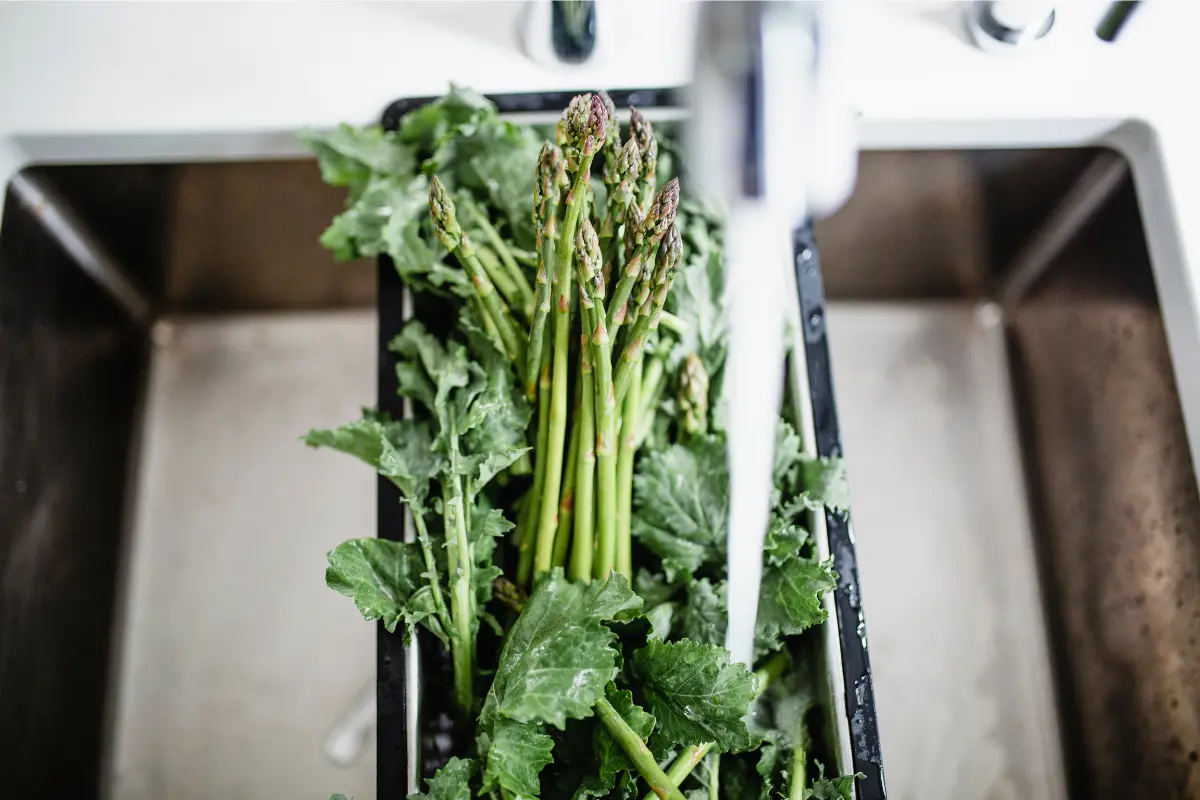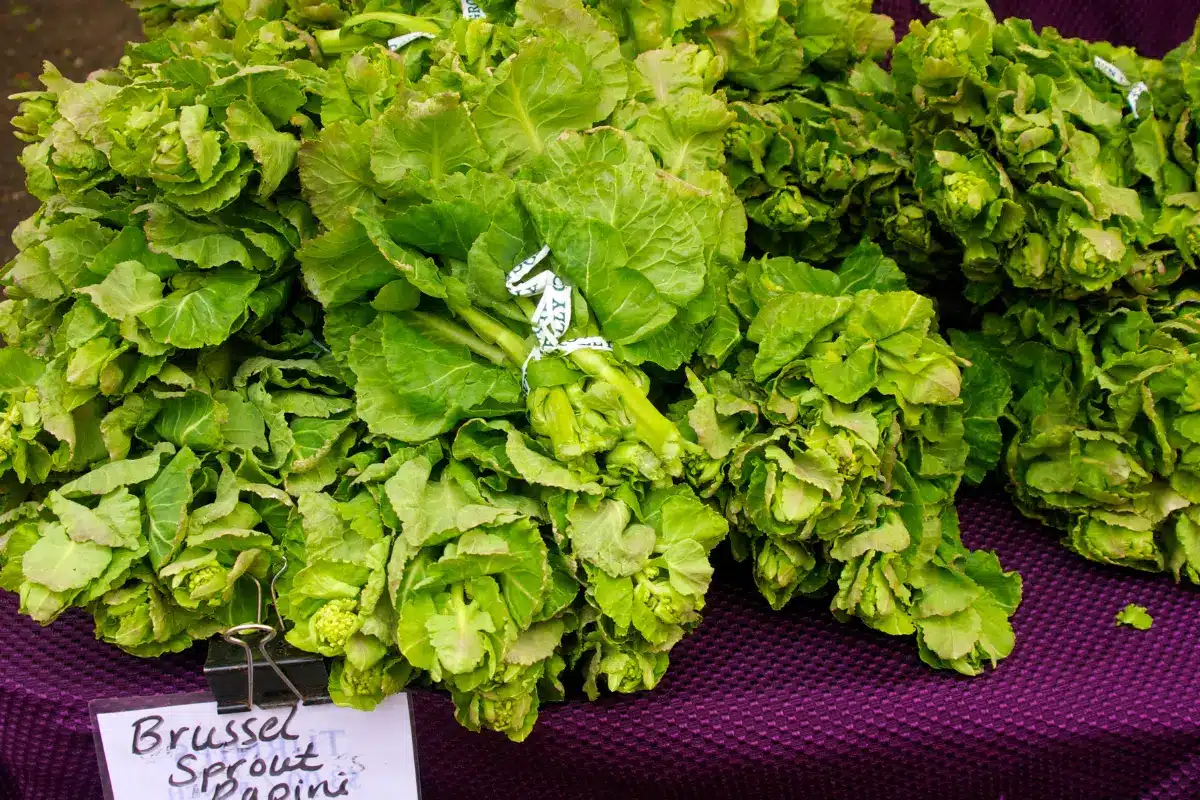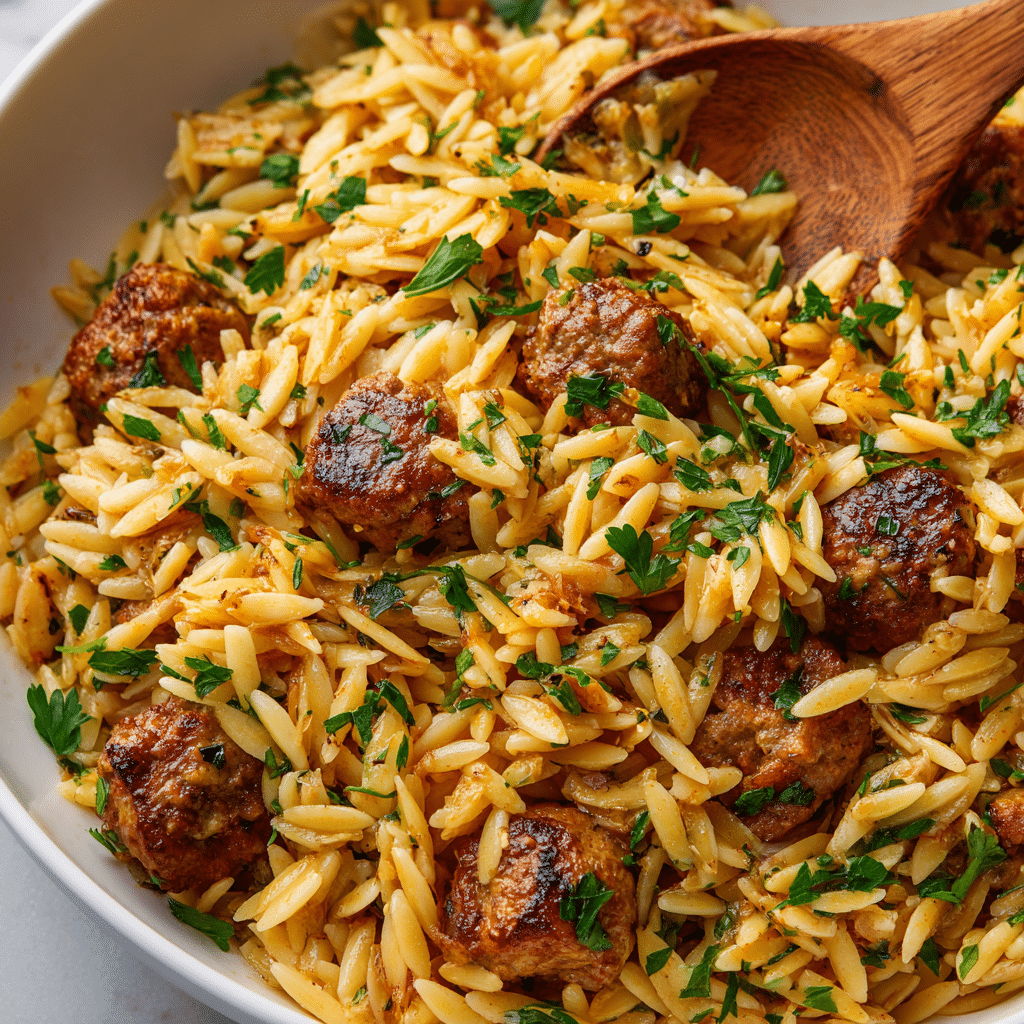Selecting and Preparing Rapini
Selecting the freshest greens and preparing them correctly can elevate your dishes from good to gourmet. Here’s how to ensure you’re working with the best possible ingredients and getting the most out of this versatile vegetable.
Choosing Fresh Greens at the Market
When at the market, look for greens with vibrant leaves and firm stalks. The buds should be tightly closed, and the leaves free from any yellow spots or signs of wilting. Freshness is key, so if it looks lively and bright, you’re on the right track.
Cleaning and Prepping for Cooking
Once you’ve selected the best greens, it’s time to prepare them for cooking. Start by rinsing under cold water to remove any dirt or grit. Trim the bottom of the stalks, as they can be tough, and cut into bite-sized pieces for even cooking.
Reducing Bitterness
The hallmark of this vegetable is its bitter edge, but if you prefer a milder taste, a quick blanch can help. Simply boil for one to two minutes before plunging into ice water. This process mellows the bitterness, making it more palatable for those sensitive to strong flavors.
By choosing the freshest greens and preparing them with care, you set the stage for a myriad of dishes that boast both nutritional value and delicious complexity. Whether incorporating into a pasta dish or serving as a side, properly prepared greens can elevate your meal with a touch of elegance.
Classic Rapini Recipe
Dive into the essence of this leafy green’s culinary appeal with a timeless dish that accentuates its robust flavors. This straightforward yet delectable sautéed dish with garlic is an excellent introduction to utilizing this vegetable in your cooking repertoire.
Ingredients List
- 1 bunch of broccoli rabe, approximately 1 pound
- 3 tablespoons of high-quality olive oil
- 3 cloves garlic, thinly sliced
- ¼ teaspoon of red pepper flakes (optional)
- Salt, to taste
Step-by-Step Cooking Instructions
- Prepare the Green: Begin by thoroughly washing the broccoli rabe under cold water. Trim the ends of the stalks and cut the vegetable into 2-inch pieces for uniform cooking.
- Blanching Step: Bring a large pot of salted water to a boil. Add the greens and blanch for about 1 to 2 minutes to lessen its sharp taste. Drain and immediately rinse under cold water to halt the cooking process.
- Sauté the Garlic: Heat the olive oil in a large skillet over medium heat. Add the sliced garlic and cook until fragrant, about 1 minute. For those who enjoy a bit of spice, this is the moment to sprinkle in the red pepper flakes.
- Incorporate the Greens: Add the blanched greens to the skillet. Sauté, stirring occasionally, until the greens are tender and the flavors meld, roughly 3 to 5 minutes. Season with salt according to your preference.
- Ready to Serve: Transfer the cooked greens to a serving dish. They can be enjoyed as a standalone side or alongside your favorite Italian mains for a complete meal.
Chef’s Tips for a Perfect Dish
- Avoid overcooking during the blanching phase to maintain the perfect texture.
- Keep a close eye on the garlic to prevent it from burning, as this could introduce a bitter flavor.
- The amount of red pepper flakes can be adjusted to suit your heat preference.
This classic dish is a testament to the vegetable’s versatility and rich flavor profile. By following these simplified steps, you’ll have a delicious side dish that brings a touch of Italian elegance to any meal.
Advanced Rapini Recipes
Elevate your kitchen game with these sophisticated recipes that showcase the versatility and depth of flavor of broccoli rabe. Each dish brings a unique twist to this beloved green, promising to impress at any meal.
Pasta with Broccoli Rabe and Sausage
- Ingredients:
- 1 pound of your preferred pasta
- 1 bunch of broccoli rabe, trimmed and chopped
- 1 pound of Italian sausage, casings removed
- 2 tablespoons of olive oil
- 4 cloves of garlic, minced
- ½ teaspoon of red pepper flakes
- Salt and freshly ground black pepper, to taste
- Grated Parmesan, for serving
- Instructions:
- Cook the pasta as per the package directions. Reserve 1 cup of the pasta water for later.
- In a skillet, cook the sausage until browned. Set aside.
- In the same skillet, add olive oil and sauté garlic and red pepper flakes.
- Add the broccoli rabe, cooking until tender.
- Combine pasta, sausage, and broccoli rabe, adding pasta water as needed.
- Season and serve with Parmesan.
Spicy Sautéed Broccoli Rabe
- Ingredients:
- 1 bunch of broccoli rabe, prepared
- 3 tablespoons of olive oil
- 3 cloves of garlic, sliced
- ½ teaspoon of chili flakes
- Salt, to taste
- Instructions:
- Blanch the greens briefly, then drain.
- Heat oil and cook garlic and chili until aromatic.
- Add the greens, sautéing until coated and tender.
- Season with salt and serve as a flavorful side.
Baked Broccoli Rabe with Parmesan
- Ingredients:
- 1 bunch of broccoli rabe, ready to cook
- 2 tablespoons of olive oil
- 2 cloves of garlic, minced
- Salt and pepper, to taste
- ½ cup of grated Parmesan cheese
- Instructions:
- Preheat your oven to 375°F (190°C).
- Toss the greens with oil, garlic, salt, and pepper.
- Bake for 10 minutes, sprinkle with Parmesan, and bake for 5 more minutes.
These recipes are designed to bring out the best in broccoli rabe, from the hearty and satisfying pasta dish to the spicy side and the cheesy baked creation. Experimenting with these dishes will not only expand your culinary skills but also introduce new flavors and textures to your dining table.
Serving and Pairing Suggestions
Once you’ve mastered the art of cooking rapini, the next step is to serve it in a way that complements its unique flavors. Whether you’re enjoying rapini as a side dish or incorporating it into a main course, these serving and pairing suggestions will help you create balanced and delicious meals.
Best Pairings with Rapini Dishes
Rapini‘s slightly bitter taste makes it a perfect complement to rich and savory dishes. Here are some top pairing suggestions:
- With Pasta: Rapini goes exceptionally well with pasta, especially when paired with bold ingredients like sausage, garlic, and chili flakes. The bitterness of the rapini balances the richness of the pasta and sauce, creating a harmonious dish.
- As a Side to Meat: The robust flavor of rapini pairs beautifully with grilled or roasted meats. Whether it’s a juicy steak, tender chicken, or flavorful pork, rapini adds a refreshing contrast to these protein-rich dishes.
- In Sandwiches and Wraps: For a vegetarian option, consider using sautéed rapini as a filling for sandwiches and wraps. Combine it with roasted red peppers and provolone cheese for an Italian-inspired treat.
Creative Ways to Serve Rapini
To elevate your rapini dishes, consider these creative serving ideas:
- Pesto: Blend sautéed rapini with garlic, nuts, Parmesan cheese, and olive oil to create a vibrant pesto. Serve it with pasta or as a spread on bruschetta.
- Rapini and Bean Salad: Combine blanched rapini with white beans, cherry tomatoes, and a lemony vinaigrette for a refreshing salad that’s packed with nutrients and flavor.
Rapini Serving Suggestions
When serving rapini, keep these tips in mind to enhance its appeal:
- Balance the Bitterness: If you’re serving rapini to guests who may not be accustomed to its bitter taste, consider blanching it before cooking to soften the bitterness. This makes it more palatable for a wider audience.
- Highlight the Flavor: Use ingredients that complement rapini’s bold flavor, such as garlic, chili flakes, and lemon juice. These add depth and brightness to the dish, making it more flavorful.
By thoughtfully pairing and serving rapini, you can create meals that are not only nutritious but also full of exciting flavors and textures. Whether you’re looking for a hearty main course or a light side dish, rapini offers endless possibilities for delicious culinary creations. Stay tuned for our next section, where we’ll share essential tips for storing and reheating your rapini dishes, ensuring they remain fresh and tasty.
Storage and Reheating Tips
To keep your rapini</span> dishes tasting as fresh and delightful as when you first made them, proper storage and reheating techniques are crucial. Whether you’ve prepared a large batch of sautéed rapini or have leftovers from a rapini-infused pasta dish, these tips will ensure your greens stay delicious and vibrant.
How to Store Leftover Rapini</span>
- Cool Quickly: Allow your cooked rapini to cool to room temperature before storing. However, don’t leave it out for more than 2 hours to avoid bacterial growth.
- Airtight Containers: Transfer the cooled rapini to airtight containers. This will protect it from absorbing odors from the fridge and also prevent it from drying out.
- Refrigeration: Store your container of rapini in the refrigerator. Properly stored, it can last for 3 to 5 days.
Best Practices for Reheating Rapini</span>
- Microwave with Care: For a quick reheating method, use the microwave. Sprinkle a little water over the rapini to prevent it from drying out, and cover it with a microwave-safe lid or wrap. Heat on high for 1 to 2 minutes, or until it’s heated through.
- Stovetop Method: Reheating on the stovetop can help retain the texture of the rapini better than the microwave. Simply heat a pan over medium heat, add the rapini with a splash of water or olive oil, and stir until it’s warmed throughout. This method is particularly good for sautéed or blanched rapini.</span>
Keeping Rapini Fresh
If you find yourself with a bunch of raw rapini that you’re not ready to cook immediately, you can extend its freshness with these steps:
- Trim the Ends: Trim a small portion off the bottom of the stems to help the rapini absorb moisture.
- Water Jar: Place the trimmed rapini in a jar or glass of water, just like you would with fresh flowers.
- Refrigerate: Cover the leaves loosely with a plastic bag and store the jar in the refrigerator. Change the water every day or two. This method can keep your rapini fresh for up to a week.
By following these storage and reheating tips, you can enjoy your rapini dishes for several days after cooking. Not only does this help in reducing food waste, but it also means you can savor the delicious flavors of rapini without having to cook from scratch every day. Stay tuned for our final section, where we’ll answer some frequently asked questions about rapini, helping you become a true rapini aficionado.
FAQs
Rapini, with its distinct taste and versatility, often brings up a host of questions from both seasoned cooks and those new to this green. Here, we address some of the most common inquiries, shedding light on how to make the most of this flavorful vegetable.
Do You Eat the Leafy Part of Broccoli Rabe?
Absolutely! Every part of the rapini</span>—from the leaves to the stalks and even the buds—is edible. The leafy parts, in particular, pack a lot of flavors and add a nice texture to dishes. They’re great for sautéing or adding to soups and stews. So, don’t shy away from using the whole plant to maximize both flavor and nutrition.
How Do You Get the Bitterness Out of Broccoli Rabe?
The characteristic bitterness of rapini</span> can be mellowed with a few simple cooking techniques:
- Blanching: Before sautéing or adding rapini to dishes, blanch it in boiling water for 1 to 2 minutes, then immediately plunge it into ice water. This process helps reduce its bitterness.
- Pairing with Fats: Cooking with fats like olive oil, butter, or bacon can also help balance its bitter taste.
- Adding Acids: A splash of vinegar or lemon juice towards the end of cooking can cut through the bitterness and add a refreshing zing.
Why Is My Sautéed Rapini Mushy?
If your sautéed rapini turns out mushy, it’s likely due to overcooking. Here are a few tips to avoid this:
- Mind the Blanching Time: If you choose to blanch rapini, keep it brief—no more than 1 to 2 minutes. Over-blanching can start to break down the fibers, leading to a mushy texture once sautéed.
- Sauté with Care: When sautéing, keep the heat on medium and watch the cooking time. Rapini is best enjoyed when it’s tender but still has a bit of bite.
Can Rapini Be Eaten Raw?
While rapini</span> is typically cooked to soften its bitter taste, young, tender leaves can be eaten raw. They make a peppery addition to salads, similar to arugula. However, the mature stalks and leaves are generally too bitter and fibrous to enjoy uncooked.
How Can I Incorporate Rapini into My Diet?
Rapini</span> is incredibly versatile. Beyond the classic sautéed with garlic, you can:
- Roast it: Toss with olive oil, salt, and your favorite seasonings, then roast until crispy.
- Blend it into pesto: Substitute rapini for basil in your favorite pesto recipe for a bold flavor twist.
- Add it to pasta: Chop and sauté rapini, then mix it into pasta dishes for added nutrients and flavor.
- Use it in soups: Rapini adds depth to soups and stews, especially those with beans or sausage.
By exploring these FAQs, you’re now better equipped to enjoy rapini in a variety of dishes. Whether you’re aiming to reduce its bitterness or simply looking for new ways to incorporate this nutritious green into your meals, these tips and tricks can enhance your culinary experience with rapini.</span>






